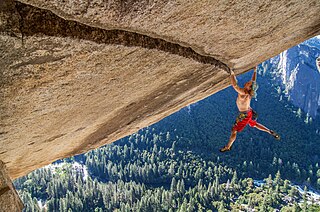
Climbing is the activity of using one's hands, feet, or other parts of the body to ascend a steep topographical object that can range from the world's tallest mountains to small boulders. Climbing is done for locomotion, sporting recreation, for competition, and is also done in trades that rely on ascension, such as rescue and military operations. Climbing is done indoors and outdoors, on natural surfaces, and on artificial surfaces

Many climbing routes have a grade that reflects the technical difficulty—and in some cases the risks and commitment level—of the route. The first ascensionist can suggest a grade, but it will be amended to reflect the consensus view of subsequent ascents. While many countries with a strong tradition of climbing developed grading systems, a small number of grading systems have become internationally dominant for each type of climbing, which has contributed to the standardization of grades worldwide. Over the years, grades have consistently risen in all forms of climbing, helped by improvements in climbing technique and equipment.
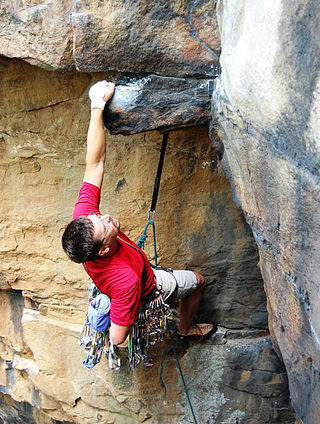
Traditional climbing is a type of free climbing in rock climbing where the lead climber places the protection equipment while ascending the route; when the lead climber has completed the route, the second climber then removes the protection equipment as they climb the route. Traditional climbing differs from sport climbing where the protection equipment is pre-drilled into the rock in the form of bolts.

Glossary of climbing terms relates to rock climbing, mountaineering, and to ice climbing.

In mountaineering and climbing, a first ascent, is the first successful documented climb to the top of a mountain or the top of a particular climbing route. Early 20th-century mountaineers and climbers focused on reaching the tops of iconic mountains and climbing routes by whatever means possible, often using considerable amounts of aid climbing, and/or with large expedition style support teams that laid "siege" to the climb.

Ice climbing is a climbing discipline that involves ascending routes consisting of frozen water. To ascend the route, the ice climber uses specialist equipment, particularly double ice axes and rigid crampons. To protect the route, the ice climber uses steel ice screws that require skill to employ safely and rely on the ice holding firm in any fall. Ice climbing routes can vary significantly by type, and include seasonally frozen waterfalls, high permanently frozen alpine couloirs, and large hanging icicles.

Free climbing is a form of rock climbing in which the climber can only use climbing equipment for climbing protection, but not as an aid to help in their progression in ascending the route. Free climbing, therefore, cannot use any of the tools that are used in aid climbing to help overcome the obstacles encountered while ascending a route. The development of free climbing was an important moment in the history of rock climbing, including the concept and definition of what determined a first free ascent of a route by a climber.
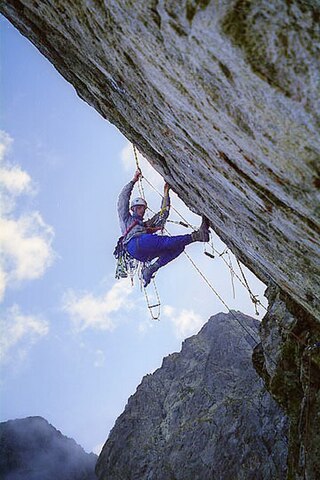
Aid climbing is a form of rock climbing that uses mechanical devices and equipment, such as aiders, for upward momentum. Aid climbing is the opposite of free climbing, which only uses mechanical equipment for protection, but not to assist in upward momentum. "Traditional aid climbing" involves hammering in permanently fixed pitons and bolts, into which aiders are clipped, whereas "clean aid climbing" avoids hammering, using only removable placements.

Sport climbing is a type of free climbing in rock climbing where the lead climber clips into pre-drilled permanent bolts for their protection while ascending a route. Sport climbing differs from the riskier traditional climbing where the lead climber has to insert temporary protection equipment while ascending.

Rock climbing is a sport in which participants climb up, across, or down natural rock formations or indoor climbing walls. The goal is to reach the summit of a formation or the endpoint of a usually pre-defined route without falling. Rock climbing is a physically and mentally demanding sport, one that often tests a climber's strength, endurance, agility and balance along with mental control. Knowledge of proper climbing techniques and the use of specialized climbing equipment is crucial for the safe completion of routes.

Multi-pitch climbing is a type of climbing that typically takes place on routes that are more than a single rope length in height, and thus where the lead climber cannot complete the climb as a single pitch. Where the number of pitches exceeds 6–10, it can become big wall climbing, or where the pitches are in a mixed rock and ice mountain environment, it can become alpine climbing. Multi-pitch rock climbs can come in traditional, sport, and aid formats. Some have free soloed multi-pitch routes.
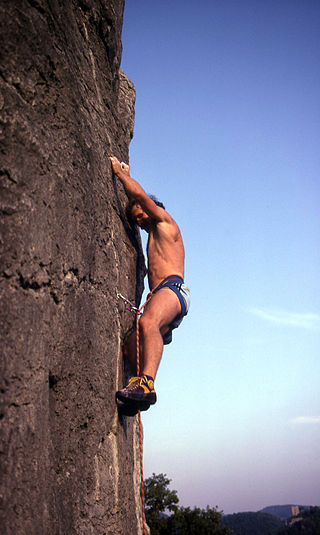
In rock climbing, redpointing means to free-climb a route from the ground to the top while lead climbing, after having practiced the route or after having failed first attempt. Climbers will try to redpoint a route after having failed to onsight it, or flash it. The first successful redpoint of a route, in the absence of any prior onsight or flash, is recorded as the first free ascent (FFA) of that route.
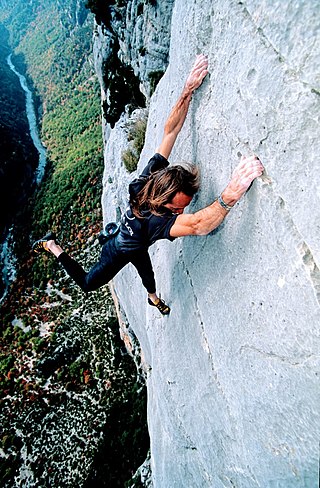
Free solo climbing, or free soloing, is a form of rock climbing where the climbers climb solo without ropes or other protective equipment, using only their climbing shoes and their climbing chalk. Free soloing is the most dangerous form of climbing, and, unlike bouldering, free soloists climb above safe heights, where a fall can be fatal. Though many climbers have free soloed climbing grades they are very comfortable on, only a tiny group free solo regularly, and at grades closer to the limit of their abilities.

Beta is a climbing term that designates information about how to ascend a climbing route. Traditionally sourced in climbing guidebooks, online databases and apps now provide detailed climbing beta. The term is attributed to Texan climber Jack Mileski.

In the history of rock climbing, the three main sub-disciplines—bouldering, single-pitch climbing, and big wall climbing—can trace their origins to late 19th-century Europe. Bouldering started in Fontainebleau, and was advanced by Pierre Allain in the 1930s, and John Gill in the 1950s. Big wall climbing started in the Dolomites, and was spread across the Alps in the 1930s by climbers such as Emilio Comici and Riccardo Cassin, and in the 1950s by Walter Bonatti, before reaching Yosemite where it was led in the 1950s to 1970s by climbers such as Royal Robbins. Single-pitch climbing started pre-1900 in both the Lake District and in Saxony, and by the late-1970s had spread widely with climbers such as Ron Fawcett (Britain), Bernd Arnold (Germany), Patrick Berhault (France), Ron Kauk and John Bachar (USA).
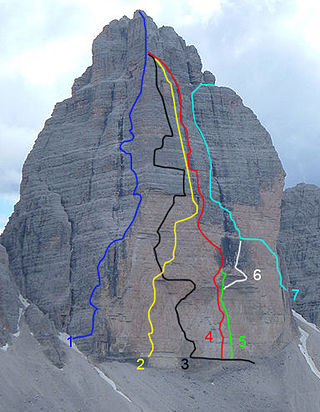
In climbing, a topo is a graphical representation of a climbing route. Topos range from a photograph of the climb on which the line of the route is overlaid, to a detailed diagram of the key features and challenges of the climb.

Big wall climbing is a form of rock climbing that takes place on long multi-pitch routes that normally require a full day, if not several days, to ascend. In addition, big wall routes are typically sustained and exposed, where the climbers remain suspended from the rock face, even sleeping hanging from the face, with limited options to sit down or escape unless they abseil back down the whole route. It is therefore a physically and mentally demanding form of climbing.

Mixed climbing is a climbing discipline used on routes that do have not enough ice to be pure ice climbs, but are also not dry enough to be pure rock climbs. To ascend the route, the mixed climber uses ice climbing tools, but to protect the route, they use traditional or sport rock climbing tools. Mixed climbing can vary from routes with sections of thick layers of ice and sections of bare rock to routes that are mainly bare rock but which is “iced-up”.

Midnight Lightning is a 7.62-metre (25.0 ft) high granite bouldering route on the Columbia Boulder in Camp 4 of Yosemite National Park. When first solved in May 1978 by American rock climber Ron Kauk, it was graded at V8 (7B/7B+), which was the world's second-ever boulder route at that grade, and the first in North America. Even today, the route is still considered a "hard" V8 grade. Midnight Lightning is the most notable bouldering route in climbing along with Dreamtime, and its ascent is considered an important moment in the history and the development of bouldering as a sport in its own right.

Alpine climbing is a type of mountaineering that involves using any of a broad range of advanced climbing skills, including rock climbing, ice climbing, and/or mixed climbing, to summit typically large routes in an alpine environment. While alpine climbing began in the European Alps, it is used to refer to climbing in any remote mountainous area, including in the Himalayas and in Patagonia. The derived term alpine style refers to the fashion of alpine climbing to be in small lightly-equipped teams who carry all of their own equipment, and do all of the climbing.

!["Topo" of a multi-pitch alpine climbing route on the South West Pillar of the Aiguille des Deux Aigles [pt] (500-metres, grade TD) DeuxAigles-PilierSW.svg](http://upload.wikimedia.org/wikipedia/commons/thumb/1/11/DeuxAigles-PilierSW.svg/220px-DeuxAigles-PilierSW.svg.png)






















